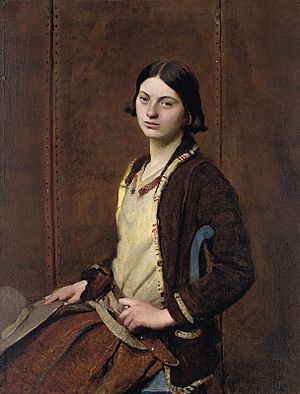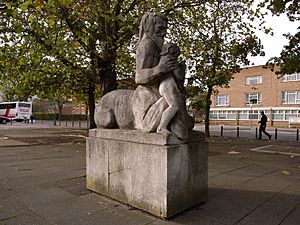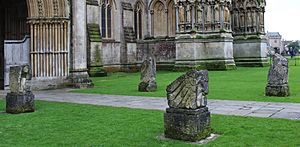Mary Spencer Watson facts for kids
Quick facts for kids
Mary Spencer Watson
|
|
|---|---|

Mary Spencer Watson by George Spencer Watson, 1930.
|
|
| Born | 7 May 1913 London, England
|
| Died | 7 March 2006 (aged 92) Langton Matravers, Dorset
|
| Education |
|
| Known for | Sculpture |
Mary Spencer Watson (born May 7, 1913 – died March 7, 2006) was a talented English sculptor. She was born in London but spent most of her life in Dorset, a county in England. Mary was greatly inspired by watching stone carvers work with local Purbeck stone near her family home. Her amazing sculptures can be found in important places like Cambridge University and Wells Cathedral.
Contents
Mary Spencer Watson's Life Story
Mary Spencer Watson was born in London in 1913. In 1923, when she was ten years old, her family moved to a country house in Dorset. Her father, George Spencer Watson, was also an artist. Her mother, Hilda, was a dancer and mime artist.
Growing Up at Dunshay Manor
Mary's father bought a special house called Dunshay Manor. It was located near Langton Matravers on the Isle of Purbeck. This manor became Mary's home for the rest of her life. Her family decorated the house in the Arts and Crafts style. They used the outdoor buildings as art studios and for dance and theater shows.
Near Dunshay Manor, there were many stone quarries. Mary was fascinated by the local stone carvers and quarrymen. She watched them use traditional tools to shape the local Purbeck stone. This experience made her decide to become a sculptor herself.
Mary's Art Education
Mary began her art training by attending Bournemouth Municipal College. She went there one day a week in 1929 and 1930. This helped her create a portfolio to apply to the Royal Academy Schools.
She was first turned down by the Royal Academy. So, Mary studied at the Slade School of Art in London for a year. After that, she was accepted into the Royal Academy Schools in 1932. She studied there for three years and won several awards. To get more experience with carving, she also studied at the Central School of Arts and Crafts in 1936. There, she learned from famous sculptors like John Skeaping and Alfred Turner.
Early Exhibitions and Travels
In 1937, Mary Spencer Watson had her first solo art show. It was held at the Mansard Gallery at Heal's in London. She displayed sculptures made from terracotta, marble, wood, and alabaster. Later that year, she traveled to Paris, France. She spent three months working in the studio of sculptor Ossip Zadkine. There, she created several large sculptures, including an eight-foot-tall figure.
Mary returned to England in 1938. She stayed there during World War II. During the war, she worked on a farm at Dunshay Manor. She also taught art and sculpture in schools across Dorset.
Famous Sculptures and Commissions
After the war, Mary received many important requests for her art. These were often for large sculptures in public places.
- She created Magic Beast for a school in Longbridge.
- She also made Chiron Teaching the Young Hero for Harlow New Town.
In 1953, Mary visited Greece. This trip inspired her to create Musician, a large sculpture made from Purbeck stone. This piece was shown at the Royal Academy in 1955. An architect named Sir Edward Maufe saw it and asked her to create two gilded angels for Guildford Cathedral.
In 1958, Mary completed a project for Cambridge University. She made a series of carvings for the outside of the Chemistry Faculty Building. These carvings showed the university's symbols and five alchemy symbols. Her sculptures called Four Symbols of the Evangelists, made from Purbeck stone, now lead to the north entrance of Wells Cathedral. In 2000, she installed Purbeck Quarryman in the churchyard at Langton Matravers.
Mary's work was shown in many galleries and museums. She had solo shows at Pelter/Sands in Bristol and at Dorset County Museum. A large show of her work was held at Salisbury and South Wiltshire Museum in 2004. Some of her pieces were also displayed at Salisbury Cathedral.
Selected Exhibitions
Mary Spencer Watson's sculptures were shown in many places, including:
- Mansard Gallery, Heal's, London, 1937 (her first solo show)
- National Society of Painters, Sculptors, Engravers, Potters, 1940, 1947
- Royal Academy, London, 1940–1934
- Women's International Arts Club, 1947, 1950, 1951
- Arts & Crafts Exhibition Society, Victoria & Albert Museum, 1950
- Dorset County Museum, 1976, 1981, 1998 (solo shows)
- New Art Centre, London, 1985, 1989, 1990 (solo shows)
- New Art Centre, Roche Court, Wiltshire, 1987–2004
- Pelter Sands, Bristol, 1988, 1990
- Cookham Trinity Arts Festival, 1994 (solo show)
Images for kids
See also
 In Spanish: Mary Spencer Watson para niños
In Spanish: Mary Spencer Watson para niños






